
May 2020
Capitalism Is Killing Us
Homelessness and Coronavirus in NYC
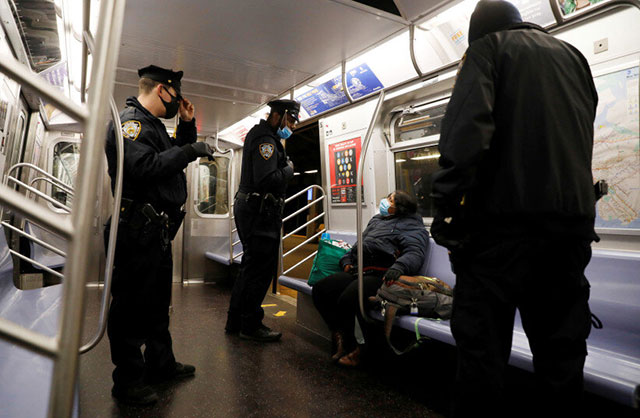
Police remove woman from New York City subway on May 7 during late-night shutdown aimed at forcing the homeless off the trains and out of the stations. (Photo: Reuters)
Much of New York City ground to a standstill amid the coronavirus pandemic as Governor Andrew Cuomo’s March 20 “New York State on PAUSE” executive order mandated the shutdown of all but “essential” businesses. State and city governments appealed to the population to “Stay Home, Stay Safe.” This posed a problem in lower-income neighborhoods where most “essential workers” live: they had little choice but to go to their jobs, at great risk every day. At the same time, it was impossible for 4,000 homeless people living on the street, as well as for another 79,000 in city shelters, who have no place where they can safely “stay home.”1 Their plight was thrown into sharp relief as city and state authorities ordered a late-night shutdown of the NYC subways, where many homeless sought refuge.2
The latest figures show 961 confirmed COVID-19 cases in homeless shelters (two-thirds of them in large single-adult facilities with dozens of beds in cramped spaces), of whom 76 have died from the disease (Daily News, 18 May). Even the numbers of the officially homeless greatly understate the scope of the problem. An annual survey of New York City schools showed that more than 114,000 students were homeless at some point in the year, one in ten of the total enrollment, a horrifying number. Significantly, while 34,000 had been in shelters, twice that number (74,000) had been “doubled up” in temporary arrangements with relatives, friends or others.3 Such “hidden homelessness,” not shown in official statistics, is particularly dangerous in this pandemic as the virus spread like wildfire in packed apartments and overcrowded buildings.
In motivating the late-night subway shutdown, in addition to calling subway cars filled with homeless people “disgusting,” Cuomo claimed that this was “an opportunity to engage homeless men and women who have been sleeping on trains, some of them for years.” In response to complaints about city shelters, NYPD officials said that 1,000 new Safe Haven beds (overnight beds in churches and community centers with less extensive regulations and requirements) would be offered. Yet those were only available to those contacted by street outreach teams. And having ample experience with the NYPD, the homeless are all too familiar with what “engagement” really means. Eyewitness accounts of the first week of the sweeps from the Safety Net Project of the Urban Justice Center told the real story:
“Tonight at Atlantic Terminal, at least 15-20 homeless people were kicked out into the freezing rain. It was cold out. There are no outreach, no buses, and no supplies, certainly no access to the thousands of empty hotel rooms right down the street in downtown Brooklyn. What there was were police officers, telling people they had to leave because the station was closed. Some ppl were asking police questions – Where am I supposed to go? Are there buses? Is there help? Do you have a mask? The answer was always ‘no.’ There is no help at all at the 95% of subway stations that are not ‘end of line’ stations. Even at end of line, we know that what is being offered is grossly insufficient – the offer of dangerous crowded shelter w/no social distancing in the middle of a pandemic.”
In Manhattan, Citicare minibuses, yellow school buses and Access-a-Ride minivans littered the streets, dropping off the homeless at packed shelters. The main destination was the cavernous 850-bed 30th Street men’s shelter, infamous for rampant violent incidents (and lately asbestos contamination), where staff and residents struggle to maintain social distancing. Many of those dropped off there did not go in. Also, city hospitals stopped allowing homeless people to seek refuge in waiting rooms during cold weather. They have also been transferring patients without a known address who tested positive for coronavirus but did not require acute medical care to the shelters. There they had to confront the labyrinthian COVID-19 intake protocol (see here).
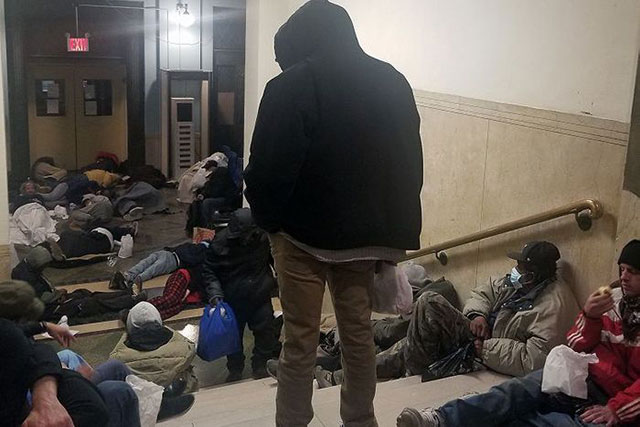
“Social distancing”? Impossible. Entrance to NYC’s 30th Street men's shelter, May 2020. No wonder homeless people shun city shelters. (Photo obtained by The City)
So what about housing the homeless in the tens of thousands of hotel rooms now standing empty? Very belatedly, the Office of Emergency Management (OEM) contracted for 11,000 hotel rooms for healthcare workers, those discharged from hospitals and those with symptoms living in cramped quarters where “social distancing” is impossible. Thousands of those rooms are still empty as hospitals continue to send symptomatic people and recovering patients home.4 In any case, those rooms are not for the homeless, who have to contact another agency, the Department of Homeless Services (DHS). Yet according to a March 26 letter from the Legal Aid Society, “In response to the crisis, the City has effectively denied access to shelter to COVID-19-positive or likely positive homeless single adults who have not had recent prior contact with DHS.”
Conditions in the shelters are terrible. According to one account, “In a small dorm, there were 100 people squashed together. There was no soap, no sanitizer; the toilets were flooded all the time” (The Intercept, 1 May). Currently, an emergency bill is before the NYC City Council which would require the city to place all homeless persons in hotel rooms, which the mayor’s office is vociferously opposing. A spokesman for the Department of Social Services denounced the bill as a “one-size fits all” approach that is “ham-fisted and reckless, self-defeatingly unilateral and ill-informed, and legally questionable and amateurish” (New York Post, 15 May). What’s actually at issue is none of the above, but who would pay for the estimated $500 million cost, the city or the Federal Emergency Management Administration (FEMA).
FEMA is the federal agency that after Hurricane Katrina inundated New Orleans in 2005, systematically blocked efforts to aid the victims, issuing a bulletin ordering first responders not to respond. FEMA turned back trailer trucks with water; prevented emergency medical teams and a 113-bed mobile hospital from reaching the city; stopped a fire-fighting team from Texas at gunpoint and diverted 1,400 firefighters from across the country on their way to the stricken city; kept the USS Bataan with a 600-bed hospital and capacity to produce 100,000 gallons of fresh water a day offshore; cut off a flotilla of 500 boats from rescuing people in the flooded city, and more.5 Rather than helping black residents return to their homes, FEMA bought tens of thousands of trailers to house them, which then had to be abandoned because of toxic levels of formaldehyde.
After Hurricane Maria devastated Puerto Rico in 2017, knocking out the island’s entire electrical system, FEMA’s local warehouse was nearly empty. It left medical clinics without generators, left thousands of trailers loaded with food, water and medicine parked on the San Juan docks and provided far less support than for hurricane-stricken areas of Florida and Texas. This is the same agency that Ronald Reagan tasked in 1984 (in “Operation Rex-84”) with planning for the detention of 400,000 undocumented immigrants at military bases in a “state of domestic national emergency”6 (as Trump has now declared over the coronavirus pandemic). And this is the outfit NYC mayor de Blasio is looking to for funding hotel rooms for the homeless?!
De Blasio and the Homeless: Endless Plans, No Action
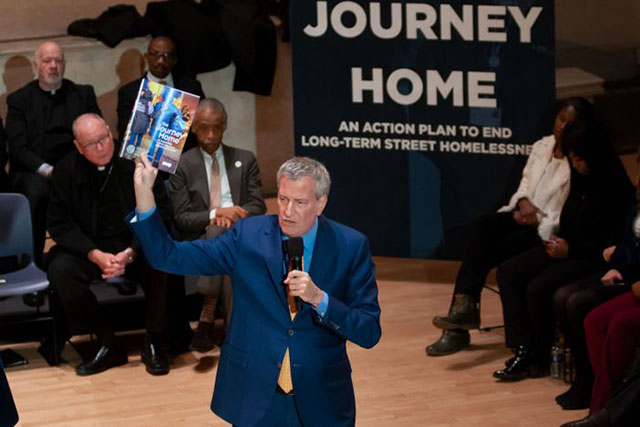
New York City mayor Bill de Blasio presents his latest plan to end street homelessness, 17 December 2019. (Photo: Ben Fractenberg/The City)
In 2013, Democrat Bill de Blasio ran for New York City mayor with a campaign centered on combatting inequality and poverty. Front and center was the fight against homelessness, which had ballooned under Republican plutocrat mayor Michael Bloomberg, under whose administration the number of homeless in the shelter system increased by 64% while the number of homeless families was up 80%.7 De Blasio talked of easing DHS restrictions on qualifying for shelter, creating new rent subsidy programs and building 100,000 new low-income housing units. At the same time, the liberal Democrat was closely tied to real estate speculators responsible for the skyrocketing rents, and received campaign contributions from slum landlords who run lousy for-profit shelters (“Hidden City,” New Yorker, 28 October 2013).
Blasio quickly fell into what has become his M.O.: making big promises, failing miserably with one janky program after another and then ignominiously pack-pedaling. This was the case with his initial opposition to charter schools, where he folded under attack by the well-connected charter lobby. The same pattern was shown more recently over integrating New York City schools, the most segregated in the country, as de Blasio backtracked on eliminating gifted-and-talented programs and screened admissions. On the homeless, in 2014, de Blasio produced a 117-page plan, Housing New York: A Five-Borough, Ten-Year Plan, to “build or preserve nearly 200,000 affordable units” and institute “a pilot rental subsidy program for homeless families.” However, only 15,000 of the projected units were for “supportive housing” with services for the homeless.
In 2015, after a scandal-mongering campaign in right-wing media over a rise in street homelessness, de Blasio’s focus switched to police action. A $22 million program was launched called NYC-SAFE, to support “New Yorkers with untreated serious mental illness who pose a concern for violent behavior.” This was combined with Home-STAT (Homeless Outreach and Mobile Engagement Street Actions Teams) to track the homeless daily in Manhattan. The NYPD was to act as “service request professionals” to “engage” the homeless. Meanwhile, the mayor and then city police commissioner, William J, Bratton, the racist enforcer of “broken windows” and “stop-and-frisk,” bragged to the media about recently breaking up 50 “service resistant” homeless encampments.
In 2017, in another switch, the de Blasio administration churned out a 128-page document, Turning the Tide on Homelessness in New York City, announcing plans to build 90 shelters across the city. Predictably, this set off a racist NIMBY (Not In My Backyard) blowback against at least 15 proposed shelter sites, including from the liberal Upper West Side and from people vowing good intentions to house the homeless, but only so long as it didn’t affect property values. In Ozone Park, hundreds of residents packed town-hall meetings fiercely opposing a proposed men’s shelter, recycling the dangerous trope portraying homeless men – mostly African American and Latino – as violent. (Homeless men are often actually the victims of brutal and senseless crime.) As of January 2020, only 30 new shelters have opened.
In July 2019, a Subway Diversion Project went into effect, in which the police, working together with Home-STAT, would daily canvass “every block from Canal Street to 145th Street” in Manhattan, “offering alternative pathways off the streets into transitional and permanent housing.” But there’s always a caveat. These services are offered “in lieu of civil summonses.” Those who refuse to be taken to intake centers are handcuffed, fined and given a summons for court proceedings. Today, the Street Homelessness Joint Command Center (JCC), operated by the NYPD and DHS,surveils the street homeless in real time, 24/7, through 20,000 police street cameras. Rather than assisting those in need, providing safe and stable homes, Democrat de Blasio, like his Republican predecessors, is criminalizing homelessness.
In December 2019, de Blasio announced yet another plan, The Journey Home, “enhancing Police Officers’ approach to engaging and offering services to unsheltered New Yorkers.” Seeking to soft-soap the message, de Blasio said, “I do not want people lost in the past thinking of what the NYPD was. Today’s NYPD are trained officers engaged with the homeless, working with medical professionals.” But anyone who has witnessed the racist cop brutality against black people, the mistreatment and persecution of immigrants, or police officers banging their batons on subway car bars to boot the homeless from the trains, knows that this is not a matter of who the police were, but of what the police are. What they are is the repressive armed apparatus of the racist capitalist state.
Former mayor Rudolph Giuliani summed up his policy on the homeless as “you chase ’em, you chase ’em, you chase ’em,” and if that doesn’t work, “you chase ’em out of the city.” Continuing this tradition, in 2014 de Blasio’s administration expelled 1,412 homeless people across state lines (and to Puerto Rico!) under the guise of compassionate reunion with their families. In 2017, a “Special One-Time Assistance Program” was launched, under which over 5,000 homeless families (12,482 people) have been sent packing to 373 cities across the country, supposedly with a year’s rent.8 Hundreds of families have returned, and some are suing for being dumped in unlivable conditions. City rulers would rather export the problem than house the homeless. For NYC mayors, the watchword is: Not in my city, not my problem.
De Blasio has issued plan after program after initiative, claiming there will be quantifiable advances in five, ten or perhaps 12 years’ time. Yet the numbers in DHS homeless shelters keep increasing, from 24,000 under Giuliani, to 31,000 under Bloomberg, to 57,000 today, plus another 26,000 when you add the other city shelters and street homeless. In the words of James Baldwin, as depicted in the film I Am Not Your Negro, talking about gradualism and black oppression in the United States: “You always told me, ‘It takes time.’ It’s taken my father’s time, my mother’s time, my uncle’s time, my brothers’ and my sisters’ time. How much time do you want for your progress?”
Empty Condos, Full Shelters and Run-Down Public Housing
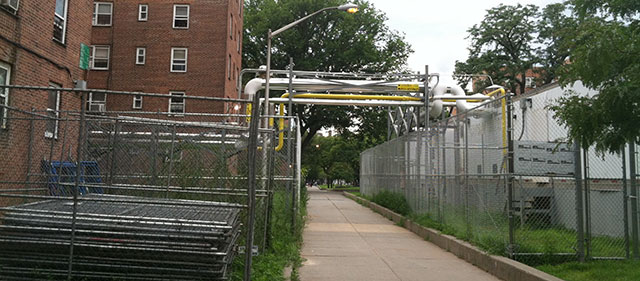
“Temporary” external boilers were hooked up after basements of Red Hook Houses were flooded in November 2012 superstorm Sandy. They’re still there seven years later. (Photo: New York City Housing Authority)
At a press conference on the planned late-night subway shutdown, Governor Cuomo said, “You’ve always had a certain number of people who were homeless for one reason or another going back decades.” It’s certainly true that there have been large numbers of homeless people in New York for a long, long time. But it’s not because of some random “one reason or another.” There was the closure of state psychiatric hospitals in the late 1970s that threw thousands of patients onto the streets. There was the curtailment of Section 8 rent subsidy vouchers. There is the decline of public housing. There are unaffordable rents. The root cause is capitalism, which necessarily generates a housing shortage, driving up rents and (as there is no way that housing for the poor can be profitable) therefore producing mass homelessness going back centuries.
In the Big Apple, the real estate lobby – along with Wall Street – calls the shots. For decades, real estate barons like Fred Trump “redlined” neighborhoods to concentrate African American and Latino populations there, depriving them of subsidized loans and mortgages, while excluding racial minorities from whites-only areas or mega-projects (such as Starrett City in Brooklyn). All this began even before the post-WWII federal subsidies that promoted home ownership in lily-white suburbs.9 Now the banks are flooding some of the same inner-city neighborhoods with investments bringing in wealthier residents, “gentrifying” and effectively driving out poorer black tenants in places like Crown Heights, Brooklyn.
After the 2008 stock market crash, as inequality skyrocketed, investors out for surefire cash switched from toxic subprime mortgages to high-end residential projects catering to affluent international buyers with money to blow during the recession. Thus the 2010s saw increased construction of glitzy luxury full-floor residences, penthouses, and massive condo towers with exclusive amenities, like Midtown’s Billionaire’s Row – eight skyscrapers with Central Park South views and a median $9.8 million sale price. During 2009-2019, 54,849 condo units were built in NYC. Meanwhile, in gentrified Williamsburg, Brooklyn, residents have seen a 54% increase in rent since 2010, as many have been displaced or ushered into homelessness.
But now most of these units sit empty because the wealthy aren’t buying, and investors are scared to sell at decreased prices, awaiting a turn in the fluctuating market. “In Manhattan, the homeless shelters are full, and the luxury skyscrapers are vacant,” begins a perceptive article in The Atlantic (16 January). Festering poverty and the ever-heightening apex of the NYC skyline highlight the dramatic contradiction marking life for millions of New Yorkers. Along with the homeless, 400,000 people live in notoriously neglected NYCHA (New York City Housing Authority) public housing, which has been the target of austerity measures for decades. Repairs take months, elevators in 23-story towers are out for days, buildings are filled with rodents and other pests and fail lead paint and mold inspections, heat and hot water are inconsistent.
In 2015, de Blasio announced a $3 billion FEMA grant to “rebuild and upgrade city public housing developments slammed by Superstorm Sandy in 2012,” mainly NYCHA complexes. Some 80,000 NYCHA residents were left “without electricity, heat and elevators for weeks – making some residents virtual prisoners in their homes.” Today, out of 200 NYCHA buildings requiring extensive repairs after Sandy, in only two have the repairs been completed (The City, 29 October 2019). The “temporary” boiler trailers outside Red Hook Houses are still there. Yet truth be told, de Blasio seems more interested in privatizing NYCHA housing than fixing them. From 2013 to 2015, NYCHA sold “54 plots with 441,000 square feet of public land to developers,” including “parking lots, green space and playgrounds,” to ease city budget woes (Daily News, 29 March 2015).
This February, NYCHA struck a deal with five developers to privatize 5,908 units in East New York, Williamsburg, Washington Heights and Harlem. The plan is moving forward, with an expected 62,000 units to be brought under private management through the Rental Assistance Demonstration (RAD) program enacted by the Democratic Obama administration. RAD doesn’t mean more repairs or better living conditions, mind you, nor is it meant to salvage public housing. In fact, the intended result is the exact opposite – more evictions – which will mean increased homelessness. Residents are worried, and rightly so. With $13 billion worth of pending repairs, the de Blasio administration would rather let private developers deal with NYCHA buildings, or demolish them, as city officials propose to do with Fulton Houses in Chelsea.
Housing the Homeless – It Will Take a Revolution
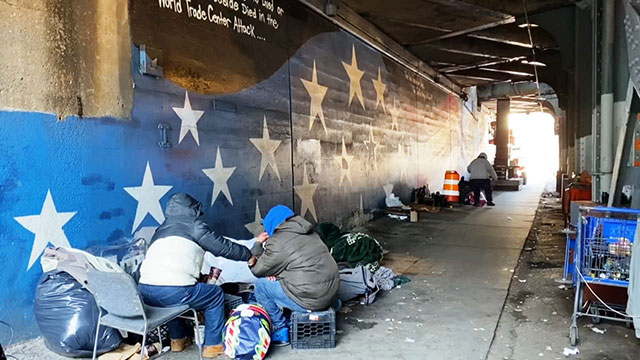
New Year's Day 2020 in Woodside, Queens, New York. As Anatole France, the celebrated French communist novelist and supporter of the Bolshevik Revolution, remarked ironically, “The law, in its majestic equality, forbids the rich as well as the poor to sleep under bridges, to beg in the streets, and to steal bread.” (Photo: NY1)
According to the 2017 New York City Housing and Vacancy Survey, there were then 75,000 pieds-à-terre in New York City. This is the traditional bourgeois name for second, third, fourth or even fifth residences used as vacation homes or investment properties, with billionaire buyers from all over: Britain, Monaco, Nigeria, Russia, China . . . or Texas. Towering skyscrapers sit mostly desolate, as owners use these condos on occasion for a few months or only a few days’ stay out of the year. With rampant real estate speculation, prices soared into the tens of millions of dollars. But in recent years the ultra-luxury market has gone bust, so that “Nearly half of new condo units in Manhattan that came to market after 2015 … remain unsold” (New York Times, 12 January). Now that the coronavirus has hit, a ruinous real estate meltdown looms in the global center of finance capital.
In 2011, Picture the Homeless, a grassroots advocacy organization, in partnership with the Hunter College Center for Community Planning and Development and the NYS Department of Health trained volunteers from high schools and colleges to canvass New York City’s five boroughs by foot looking for vacant properties – a creative venture. They found quite a few: 3,551 vacant buildings that could potentially house 71,707 people (“Banking on Vacancy: Homelessness and Real Estate Speculation,” Picture the Homeless [2011]). And then there is the hotel industry, where occupancy rates in the city’s 120,000 hotel rooms have fallen from 70% to 30% during the pandemic, and over 60 hotels have shut down.
Meanwhile, both business and residential tenants are unable to pay rents. Major realty trusts have reported that from 50% to 80% of their commercial clients have not paid their leases since the onset of the crisis, while the association of landlords of rent-stabilized apartment buildings says that 25% of tenants did not pay rent in May. The group’s executive director warned that unless the government provides relief, “we are going to see a housing disaster the likes of which we have never seen” (New York Times, 22 May). Across the country there have been embryonic rent strikes, with the hashtag #CancelRent and demands for “No Work, No Rent.” The demand has been endorsed by Congresswoman Alexandria Ocasio-Cortez, and organizers want to turn it into a mass movement like the Occupy Wall Street protests after the 2008 crash.
From destitute longtime homeless individuals and families to suddenly unemployed millennial roommates paying sky-high market-rate rents, millions of people across the country are staring a housing disaster in the face. New York City, with the largest numbers of renters (2.2 million) and homeless people in the country, will be the epicenter, as it has been for the COVID-19 pandemic. As soon as temporary bans on evictions expire, this time bomb will explode. Various “progressive” Democrats like “AOC” and opportunist pseudo-socialists who tail after them have called for moratoriums, “tax the rich” and the like. De Blasio and/or the NYC City Council will produce another plan. In places like Portland, Oregon there are movements for rent control. But NYC has had rent control since the 1940s, and it hasn’t prevented this crisis.
So long as the economy is laid low, governments at every level – city, state and federal – won’t, and in fact can’t, resolve this impending catastrophe. The Federal Reserve would have to issue endless trillions in IOUs (Treasury bonds) in order to shovel money to the parasitic real estate moguls in order to keep the banks that hold their mortgages from collapsing. Not to mention “bailing out” every other industry facing bankruptcy. The $16 trillion the feds doled out to rescue Wall Street following the 2008 stock market crash would look like chicken feed. The coronavirus depression will shake capitalism to its core. Democrats, Republicans and the entire bourgeois class vehemently defend that system, with the police and their guns, the courts and the jails – in short, the capitalist state – at the ready to enforce the dictates of capital.
So unless the working class rises up at the head of all the oppressed, leading to a revolutionary struggle for power, it is we who will pay the terrible costs of this crisis. Though triggered by a virus, it comes on top of the post-2008 depression from which world capitalism never fully recovered. (In fact, many indicators were pointing to a new major downturn even before the pandemic began.) Mass unemployment will persist, and with it the food lines and growing numbers of homeless. A couple of generations of young people face a future with dismal job prospects as the “gig economy” dries up. The toll it is already exacting on the youngest is incalculable, as public education has effectively been canceled for the poor, immigrants and others who lack the necessary resources and skills.
In a call for action by unions and workers in the pandemic, issued on March 18, our comrades of Class Struggle Workers – Portland wrote:
“The fact that everyone must have a home is even more obvious and urgent during a pandemic. A militant workers movement would work with tenants and homeless organizations to stop evictions, take over unoccupied apartments, investment properties and second homes of the wealthy and occupy hotel space to provide housing for the homeless instead of the huge profits of speculators and price-gougers.”
–“CSWP Calls for Workers Action in Coronavirus Crisis,” The Internationalist No. 59, March-April 2020
House the homeless? Absolutely. There are plenty of rooms to be had in empty hotels and vacant luxury apartments. They should be occupied now! But that raises the question: for how long? And what then? As the CSWP statement underlined:
“Ultimately, it will take a planned economy capable of redirecting production and distribution of medical equipment, safety equipment and basic necessities for a large-scale outbreak, with workplaces organized with the safety of workers as a central priority, in order to effectively fight a pandemic. That means a fight to end this capitalist system of profit-driven chaos, incompetence, racism and exploitation, and establish a workers government.”
If the bankruptcy of capitalism wasn’t painfully clear before the pandemic crisis, it surely is now. Whether to resolve mass homelessness or produce desperately needed ventilators, what’s required is to smash the moribund system in which production is for profit, not to fill human needs. To lift the impoverished out of the destitution to which they are condemned in this barbaric society that lets 100,000 lives be snuffed out in two months, it will take nothing less than international socialist revolution. To lead that fight, we must undertake the difficult task of forging a revolutionary workers party. ■
- 1. The figure of 60,000 or so in NYC homeless shelters is often cited, but that is only for facilities administered by the Department of Homeless Services.
- 2. See “Shutting Down 24/7 Service Is No Answer to NYC Subway Crisis,” The Internationalist, May 2020.
- 3. Advocates for Children of New York, “New Data Show Number of NYC Students who are Homeless Topped 100,000 for Fourth Consecutive Year” (28 October 2019)
- 4. See “A Tale of Two Cities: Wuhan – New York,” The Internationalist No. 59, March-April 2020.
- 5. See our article, “New Orleans Police State: ‘Ethnic Cleansing’ American-Style,” The Internationalist No. 22, September-October 2005.
- 6. See our article, “American Gestapo,” The Internationalist No. 19, Summer 2004.
- 7. Coalition for the Homeless, Rising Family Homelessness in NYC: What the Next Mayor Can Do (November 2013).
- 8. “NYC Secretly Exports Homeless to Hawaii and Other States Without Telling Receiving Pols,” New York Post, 26 October 2019.
- 9. See Charles Brover, “‘American Apartheid’ by Design,” Class Struggle Education Workers website, November 2018.
Friedrich Engels on the Housing Question
A century and a half ago Friedrich Engels, who together with Karl Marx authored The Communist Manifesto, wrote a study of The Housing Question (1872). In Part II on “How the Bourgeoisie Solves the Housing Question,” Engels connected the miserable housing conditions of the workers with epidemics:
“Modern natural science has proved that the so-called ‘poor districts’ in which the workers are crowded together are the breeding places of all those epidemics which from time to time afflict our towns. Cholera, typhus, typhoid fever, small-pox and other ravaging diseases spread their germs in the pestilential air and the poisoned water of these working-class quarters. In these districts, the germs hardly ever die out completely, and as soon as circumstances permit it they develop into epidemics and then spread beyond their breeding places also into the more airy and healthy parts of the town inhabited by the capitalists. Capitalist rule cannot allow itself the pleasure of creating epidemic diseases among the working class with impunity; the consequences fall back on it and the angel of death rages in its ranks as ruthlessly as in the ranks of the workers.”
In the present pandemic, it is striking how COVID-19, which did not start out as a disease of the poor, quickly became that as it ravaged the poor and immigrant neighborhoods where working people live jammed together in narrow spaces. Engels stresses that this is inherent in capitalism:
“In such a society the housing shortage is no accident; it is a necessary institution and it can be abolished together with all its effects on health, etc., only if the whole social order from which it springs is fundamentally refashioned.”
And he sums up the bourgeois “solution” to the housing question:
“The breeding places of disease, the infamous holes and cellars in which the capitalist mode of production confines our workers night after night, are not abolished; they are merely shifted elsewhere! The same economic necessity which produced them in the first place, produces them in the next place also. As long as the capitalist mode of production continues to exist, it is folly to hope for an isolated solution of the housing question or of any other social question affecting the fate of the workers. The solution lies in the abolition of the capitalist mode of production and the appropriation of all the means of life and labor by the working class itself.”
